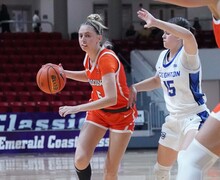E.S. Bird Library saw a host of changes this summer, such as the rewiring of its testy elevators, and has indefinitely stalled its plans to renovate the basement level.
Bird’s elevators were refurbished on the inside, and the technology that controls the elevators was updated to make them operate faster and smoother, said Pamela McLaughlin, the library’s communications director.
A redesign for the lower level of Bird this year, including adding two new classrooms, has been put on hold, said Eric Beattie, director of the Office of Campus Planning, Design and Construction.
‘We still need clarification on what needs to be done in order to move forward,’ Beattie said.
The lower-level renovations cannot be scheduled because the university needs to remove some ‘environmental materials,’ Beattie said, though he could not specify what the problem is.
The lower floor now houses an open space with tables and chairs for student use, as well as a separate room for quiet study and offices.
McLaughlin said the library also continued its recent efforts to provide more quiet study space over the summer by adding more tables and chairs on its upper levels.
Library officials also hope to introduce a radio program from Belfer Audio Laboratory and Archive Arts and Humanities Services. For the upcoming spring, Bird hopes to have 90-second spots of content produced by Belfer Archives play on National Public Radio, McLaughlin said.
As for the basement, architects and engineers finished plans for the basement’s renovations during the summer, but the project has yet to receive approval from the Office of Campus, Planning, Design and Construction due to the unspecified environmental issue, said T.C. Carrier, director of program management for Bird.
The project involves building two different-sized classrooms in the open area by the staircase in the lower level. The bigger of the classrooms will be equipped with smart technology used for instruction by library staff. The classrooms will also be a place for students to create presentations or work on group projects, Carrier said.
The renovations were initially planned because the library received funds from a donor specifically for improving the bottom floor, Carrier said.
Published on August 30, 2010 at 12:00 pm





